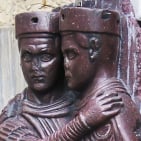Bad Private Dictionary

mauro sacchetto
Posts: 353
In modifying a font (plz note that actually I'm interested only in .otf, not in Type1), I receive the message
Bad Private Dictionary
In detail:Elements in BlueValues/OtherBlues array are disordered<br>Elements in BlueValues/OtherBlues array are too close (Change BlueFuzz)Although I searched for (Google and FontForge manual) , I didn't find a clear explanation and, much less, some directions to solve that problem. I found this explanation too: https://blogs.adobe.com/CCJKType/2012/04/the-bluevalues-array.html but I dind't understan the practical way to act. Please, be kind enough to give me the basic lines to avoid all this. Thank you
0
Comments
-
0
-
thank you. I'll read it as soon as possible.
In any case, I tried to create a font (for merely experimental reasons) of Slimbach's Adobe Premiere Pro and I received the same warnings. So I concluded (I don't know if it's right or wrong) that it's no a so serious mistake...0 -
Look at the PostScript section of Robofont Documentation. Here you will find a good decription of BlueValues.0
-
Thank you. Reading in this moment.
Only a question more: if I receive an error message like the ones I quoted above, can they have a negative impact on an .otf?0 -
Errors in BlueValues, like those cited, can effect whether and when overshoot control turns on for small ppem sizes (primarily on screen).
0 -
ok thank, you. I've to study the case and to produce the appropriate corrections0
-
I read the two texts, but I still do not understand the practical method for determining those values. Is there a kind of algorithm or should I deduce it by going to "measure" the glyphs?
0 -
There are algorithms to use to determine the interaction between BlueFuzz and the blue zones. However, the numbers depend a bit because there are several different methods for how to express the values. In FontLab Studio 5, you can use native measurements, pixels, or points.
BUT, the main thing to know is... you can set BlueFuzz to zero. That alone may resolve the problem. BlueFuzz is only there to catch outlines that are "off" and outside the blue zones. If the outlines are accurate, there is no need for it. The conflict arises when the BlueFuzz, added to existing zones, causes them to begin to run into each other.0 -
I'm using FontForge n Linux (good but not perfect: I discovered a bug only a few days ago),
but I'll try the evaluation version of FontLab in Windows.
In any case... it seems to me that there are some fixed parameters, but in certain way it's also relative. Science and art...0
Categories
- All Categories
- 46 Introductions
- 3.9K Typeface Design
- 487 Type Design Critiques
- 564 Type Design Software
- 1.1K Type Design Technique & Theory
- 656 Type Business
- 861 Font Technology
- 29 Punchcutting
- 520 Typography
- 119 Type Education
- 324 Type History
- 77 Type Resources
- 112 Lettering and Calligraphy
- 33 Lettering Critiques
- 79 Lettering Technique & Theory
- 558 Announcements
- 94 Events
- 114 Job Postings
- 170 Type Releases
- 179 Miscellaneous News
- 276 About TypeDrawers
- 54 TypeDrawers Announcements
- 120 Suggestions and Bug Reports


